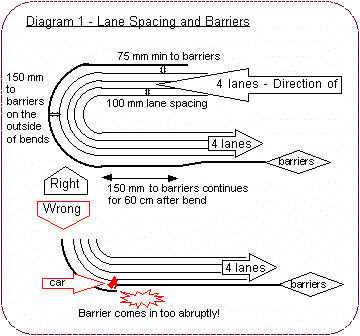
Why not design it like a real Grand Prix track?
Lane Spacing and Barrier position and track width
Bridge Design and evening up lap times
This is an edited
version of 2 articles originally published in BSCRAís "Slot Car Racing News"
magazine.
Building a slot car track requires a great deal of work and
once built the track will probably be used for several years. Its much easier
and cheaper to change a design on paper than to rebuild part of the track, so
its well worth spending some time getting the design right before you start
building.
So is this going to enable you
to design the track that will be everybodyís favorite track? No of course it's
not - ask five slot racers which is their favorite track, and they could easily
come up with six different answers. Ask them why they like or dislike particular
tracks and you'll also get a variety of answers. You can try and limit people's
answers to the design of the track, but the tracks they like best will also be
influenced by questions like are the club members friendly, are they well
organised, what's the clubroom like, how well is the track built and maintained,
is the power consistent and adequate, are the lap counts reliable and is there
convenient car parking. I am not attempting to coverall these issues , this is
an article about track layout design, other aspects of track construction will
be covered in a separate articles.
Conventional building techniques for
purpose made slot car tracks place hardly any restrictions on the layout (just
about the only parts of construction that do influence the design are that it is
sometimes convenient to tweak the design slightly to avoid unnecessary joints
between boards, and to make the pieces of portable tracks a more convenient
size). Tracks using proprietary track sections have the layout dictated by the
size of the sections - there are usually only a handful of bend radii available,
and the angles of bends are also restricted. The layout of a track built from
proprietary plastic track sections (Scalextric, Ninco, SCX Carrera
etc,) still needs thinking about in the
same way as a purpose built track. Although this article is aimed primarily at
purpose built tracks, much of it is equally applicable to proprietary track, and
it explains the difference in some of the more important points. Proprietary
track has the advantage that its relatively easy to change the layout if you
don't like your first attempt (Iíve heard of HO open meetings where they changed
the track layout during the lunch break!), but there are limited options to
change angles and radii to resolve any problems. Proprietary track is of course
only suitable for home set type cars, so clubs wanting the possibility of
running faster cars will need a purpose built track. Building your own purpose
built track can work out a good deal cheaper than purchasing proprietary track -
even for a home track.
Why not design it like a real Grand Prix track?
In the early days of slot racing some people tried building replicas of full size racing circuits. Trying to produce a true scale model of a real circuit is impractical - for example a 1/32 model of the Silverstone Grand Prix circuit would have a lap length of 160m (525 ft.) and take up a space about 53m (175 ft.) by 33m (65 ft.), (add 33% to these for the 1/24 version). Also a 1/32 scale replica of typical full size Grand Prix 5th. gear corner would have a radius of about 4.5m (15 ft.) (scaling cornering speeds properly produces unexpected results, but Iím not going into all that here). Full size circuits have large areas of paddock, car parks etc. so the layout doesn't pack as much track length in a small space as the average slot car track. Thus the replicas of full size circuits have layout plans that look a bit like their full size counterparts but in fact are nearer the scale size of a kart track. Many of the features of slot track design (explained in the rest of this article) are not relevant to full size circuits, and many of the features of a full size circuit (gravel traps, paddock areas, car parks etc.) are not relevant to slot car tracks. In short there are lots of reasons why the two should be different, so its hardly surprising that slot racing replicas of full size circuits are now rare. (Even in HO scale a huge 71m (233ft.) Le Mans circuit set up annually in Derby for the 24 hour race is only about a third of the 1/64scale lap length of the full size circuit). If you want to add a little realism to a slot track add some scenery and a pit lane in positions where they donít get in the way, and wonít be damaged by crashing by slot cars.
Some clubs aim to build a track that gives them a home track advantage. I am not going to debate if putting visitors from other clubs at a disadvantage is a good idea - I'll leave that to you! However all clubs should be trying to encourage newcomers to slot racing. Immensely complex designs that beginners cannot get round are not a good idea - If beginners are not to be discouraged they need to be able to get round without falling off several times a lap, (although they are bound to be slow and fall off several times a race). Tracks that are not too difficult to get round, but need a lot of knowledge to get round really quickly are certainly a reasonable option. Corners that open up or tighten or change camber are more tricky to learn than constant radius flat bends. Esses can be another source of home track advantage (they inevitably open out or tighten up on some if not all lanes). Tracks that are quite unlike other tracks (e.g. very long straights, (or conversely) the lack of any reasonably long straights, or with dramatic hills) will give a home track advantage, but will probably put the members at more of a disadvantage on other tracks because their cars (and perhaps their driving) will be set up to suit the "home" conditions and won't suit anybody else's track.
I donít intend to tell you what track layout you should have - thatís a matter for the club. A variety of track designs makes racing all the more interesting! What I will try and do is explain the various aspects of track design, the advantages and disadvantages of various features. The design of almost anything involves thinking about the various things you want the design to achieve, working out how to achieve them, recognising that some of them are in conflict, and coming with the best balance between the various conflicts. To put it another way, you are not likely to be able to design a track (or anything else) without some compromises. I do intend to explain what needs to be thought through to design a good track, and leave it to you to decide what's most important for your track.
I am assuming that you have a club room. Much could be written about how clubs obtain their club rooms and how they pay for them .. but Iím not going to write it now!
Tracks used for BSCRA Championship events must have at least 4 lanes and a lap length of at least 15m (50 ft.) although very few BSCRA clubs have tracks much under 25m lap length. What is the minimum practical length for club racing? The practical minimum is more question of lap time rather than lap length - if I can give an example the 16.2m GROPE track has a sports car lap time of around 3.2 sec. and is really too short, where as the 14m Scalextric club track John Reid used to run had a lap time of just under 6 sec. (with a MRRC F1) which was perfectly adequate. The space a track will occupy depends on the layout but to give some idea a 16m 4 lane track can fit in the area of a single garage, but of course you need room to walk round it so the minimum clubroom area is about twice that size. An example of very good club track in a small space is the Roedale club in Brighton which has a track room exactly 20ft x 15 ft (6.1m x 4.6m) plus a separate pit room 17ft x 8 ft (5.2m x 2.4m)
To start designing a track decide how many lanes you want. Four lanes are sufficient for most clubs, but If you have the space and members you could have 5,6 or even 8 lanes. 2 lanes are usually enough for a home track this will take up much less space than is needed for a club track.
The next stage is to measure up the club room making a note of the positions of doors, pillars and any other fixed obstructions.. don't assume you know how big the room is, measure it! Up to this point I have asked what sort of track does your club want and how much space do you have - these are decisions the involve the whole club. The next stage is to design the layout - I would advise against trying to design by committee - one or more club members should go away think about it carefully, and draw one or more track designs.
Track layouts to need to be drawn to scale (If you haven't got a drawing board or computerized way of producing scale drawings then squared paper can be used, or a ) - designs that look good on the back of a "fag packet" usually have serious flaws when drawn up properly! Here are some ideas to help with the design.
A lane spacing of at least 100mm (4 in.) is the minimum required by BSCRA rules , 110mm is the minimum recommended1/24 cars. International (ISRA 2020) rules require a minimum lane spacing of 115 mm. Lane spacing should be equal (or at least approximately equal) all the way round for BSCRA and similar type club racing. Slot stock tracks have the lane centers much reduced on part of the lap.
Barrier
Position
Modern tracks are designed so that the tail of the car does not touch the barrier in normal running. Years ago some clubs saved a couple of inches by placing the barriers closer to the slot, and long cars could be cornered with the tail rubbing on the barrier. These days that is likely to result in bodywork folded up in the rear tyres. Assuming you are going for a modern design, the gap between the slot and the barrier should really be a minimum of 100mm on straights and the inside of corners (If you really need to save some space you can go down to 75mm (3 in.) in places where the cars wonít be wiggling), and at least l50mm (6 in.) is recommended on the outside of corners and for at least the first 60cm (2 ft.) along the following straight. (NOTE International (ISRA) rules require a minimum of 150mm) The important thing is not to bring the barriers closer to the slot too abruptly on the exit of corners (see diagram 1) - otherwise a car cornering with the tail out will come into contact with the barrier with a resounding crunch risking damage to his car (and to your hearing when the driver points out the advantages of more careful track design!)
Track
Width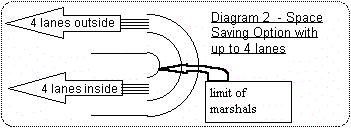
The track width can be calculated by adding the lane spacing and the gaps between the outside slots and the barriers. So, for example, a 4 lane track would have straight about 400mm (16 in.) wide with 100mm lane centres and an 8 lane about 970mm (38 in.) wide with 110mm lane centres. An important point about these widths is that a 4 lane track is narrow enough for a marshal to reach over one track section to another (see diagram 2), this isnít possible with 6 or 8 lanes - so several space - saving layout options can only be used with 4 lanes.
Bridge Design 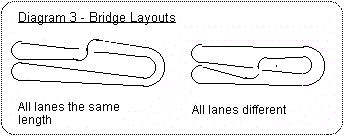
Nearly all British club tracks have one or more bridges, if done correctly (see diagram 3) an odd number of bridges will make all the lanes more or less the same length. (More or Less??? The lanes are exactly equal length on a flat track with constant lane spacing. Banked corners make a difference to the lane lengths - see the article on banked coroners , the lane spacing will not be constant if the "elliptical" slot cutting technique is used A 4 lane track with constant 100mm lane spacing and no bridge will have an outside lane 1.9 m (6 ft. 2 in.) longer than the inside lane regardless of the layout) There are some disadvantages of bridges - its difficult to marshal cars under them (careful design can reduce the risk of cars falling off under the bridge - Iíll come to that later), and the gradients needed to achieve the differences in height can be a problem. Careful design can minimise these problems but another option is not to have a bridge.
It is generally considered
desirable to have the potential lap times on each lane as equal as
possible.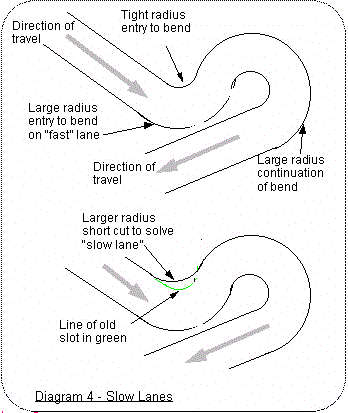
Even when the lap lengths are equal there are usually slight
differences in lap times, this often only comes to light once the track is
built. (A number of clubs, Bath for example, have eliminated this "slow lane"
problem by re-routing the slot to give the slow lane a slight short cut or
larger radius. - see diagram 4. You can only do this sort of adjustment after
the track is built, I doubt anybody can predict with certainty which the slow
lane will be in advance - if track design was that exact a science the slow
lanes could be designed out on paper!) Its more difficult to keep all the lanes
with equal lap times when there are 6 or 8 lanes, Tracks with no bridge are
likely to have larger differences between the fast and slow lanes. Tracks where
there is a significant difference in lap times are better suited to racing where
you race for equal times on all the lanes (As is almost universal on 8 lane
tracks in other countries).
Another small disadvantage of tracks with no bridge is that they tend to promote uneven tyre wear. It should almost go without saying that cars handle best with identical size rear tyres. People who have done endurance races on tracks without bridges report uneven tyre wear. At least one team deliberately produced "pairs" of new tyres where the "outside" tyre was larger diameter, when both tyres had worn down to the point where they needed changing the "outside" tyre was the smaller of the two. (So for most of the time the tyres were much more similar in diameter than if they had started out with them the same size). For short races this effect probably isnít noticeable. It also has to be said that some tracks do cause uneven tyre wear even though all the lanes are the same length - (often the outside tyre wears more in long fast corners - and they certainly wear faster when there is more rubber on teh track - anybody got any good explanations of why?).
Bridges - where to put them
Earlier on I asked do you want a bridge? ... well if the answer was yes where do you put it?
A competitors driving error causing his car to fall off and loosing him a second or two is an integral part of slot racing. His error - heís delayed - fair enough! However tracks should be designed to reduce the chances of one drivers mistake becoming everybodyís accident. (There are other outlets for people who enjoy lotteries!)
Bridges block both the drivers and marshals view. Marshals tend to obstruct several lanes when retrieving cars from under the bridge. A good track design should make accidents under the bridge a very rare occurrence. (I say very rare - if you think its impossible to land up on any part of the track running area, somebody will prove you wrong! There are always examples of bad driving and evil handling cars to defeat the track designers best efforts). So where do you put a bridge?
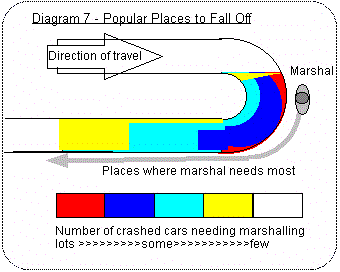
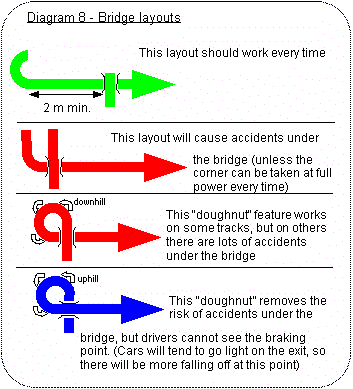
(a) Donít put corners under a bridge.
(b) Donít put bridges over straights immediately after corners. Diagram 7 illustrates the parts of a straight where cars tend to fall off - on medium speed corners 2 metres (6-7ft.) should be sufficient, on really fast corners try for rather more. Ideally the more space you can allow between the exit to a corner and going under a bridge the better - but see (c).
(c) Try to avoid a bridge over
the braking point - (some drivers feel they need to see their car at the braking
point, others have no difficulty in braking the appropriate split second after
the car has gone under the bridge - but they certainly need to see the car
shortly before the braking point).Diagram 8 gives some options for bridge
layouts with some comments on how well they should work. The bottom layout is a
feature of the Haydon track. (The complete layout of this track is shown in the
Oct/Nov 1998 SCRN). This doughnut works well, indeed their previous 2 tracks
have successfully incorporated this sort of feature, and they have no doubt
learned how to do it properly. However, its not all that easy to get this sort
of feature right, particularly the camber / gradient of the road and visibility
- so approach with care!
If you are building a home track it may not be worth the trouble of building a bridge, and particularly with a 2 lane track a short cut can be built in to the outside lane to speed up the lap times. (See separate article)
The inside corner radius should not be too tight - some people would say at least 15Omm (6 in.) others would say at least 230mm (9in.), and few club tracks have more than one bend as tight as this. In fact the inside bend radius on most corners is over 30cm (12 in.) and tight Inside bend radii appear to contribute to making the inside lane a 'slow lane'. This 'slow lane' problem tends to be worse in layouts when one lane leading in has quite a sharp radius followed by a large radius where as there is much less change of radius in the other lanes (see diagram 4). This question of minimum bend radius also effects the minimum width a track can occupy, for example a 180 degree bend in a 4 lane track with recommended spacing must have a overall width of 1.15m (3 ft. 9 in). If you are really short of space you could pinch the lane centres and spin out areas slightly. If you need 2 such bends side by side (this Is likely If you are trying to build a track in a very restricted width club room) then obviously the space saved is doubled. A final thought on bends - it tends to make track more interesting if there are a variety of different corner radii and angles so donít feel constrained - come up with something original!
|
Very large radius bends have become increasingly popular both as a curved main "straight" in front of the drivers and also elsewhere on a layout. Both were used on the 2008 World Championship track (see photo >) Routing these very large bends is no problem with CNC machining, but are probably impractically to rout with a radius arm given the size of workshop and radius arm that would be needed. Curved main "straights" .
This has become popular on 8 lane tracks, indeed ISRA rules for World
Championship tracks say "The track must be designed with curved drivers
straight or curved drivers panel to give good visibility from all drivers
positions." (2019 ISRA Handbook). The bend radius on theses
curved main straights is typically somewhere around 25 meters.
Assuming the track is reasonably well leveled, that drives just like a straight
and is safely flat with absolutely everything. However, at one
national event this track was not set up properly and some cars twitched far
enough sideways to touch the car in the next lane. Very large radius bends can be useful when designing layouts in that the smaller bends (the ones that need a marshal) can be arranged for improved marshalling access, driver visibility and reduced risks of deslotted cars under bridges. Of course very large radius bends don't need to be incorporated just because you can, it's better to think of them as another "tool in the toolbox" the skilled designer can use. How big does the bend radius need to be so it can safely be taken flat out with just about everything? About 7.4 meters radius works when absolutely level, but unsurprisingly is more sensitive to set up than larger radius bends. A very slight amount of adverse camber made cars noticeably less stable and a small amount of banking (6mm packing under the outside legs) can make even slightly bent cars a lot more stable |
|
Hills and Banking
Hills and banking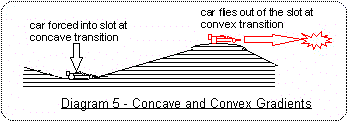 If your layout has one or more bridges you will need
changes in level of the track surface. At least 8 cm (3 1/4 in.) is needed
for marshals hands under bridges. This means hills, and these can be dangerous
to cars if not designed properly. The main problem is the transition from one
gradient to another (see diagram 5). If this is concave (in side view) the cars
will be forced down onto the track as they pass over. This is good at keeping
the cars in the slot but if the transition is too sharp the car tend
to ground and damage the track. This grounding is not generally a problem if the
transition is in the middle of a sheet of board, because the board will not bend
to too sharp a radius. If however the transition is convex the cars tend to fly
out of the slot. Even cars that appear quite slow in a straight line can be
prone to deslot over bumps in the track, and these convex transitions make these
problems far worse.
If your layout has one or more bridges you will need
changes in level of the track surface. At least 8 cm (3 1/4 in.) is needed
for marshals hands under bridges. This means hills, and these can be dangerous
to cars if not designed properly. The main problem is the transition from one
gradient to another (see diagram 5). If this is concave (in side view) the cars
will be forced down onto the track as they pass over. This is good at keeping
the cars in the slot but if the transition is too sharp the car tend
to ground and damage the track. This grounding is not generally a problem if the
transition is in the middle of a sheet of board, because the board will not bend
to too sharp a radius. If however the transition is convex the cars tend to fly
out of the slot. Even cars that appear quite slow in a straight line can be
prone to deslot over bumps in the track, and these convex transitions make these
problems far worse. 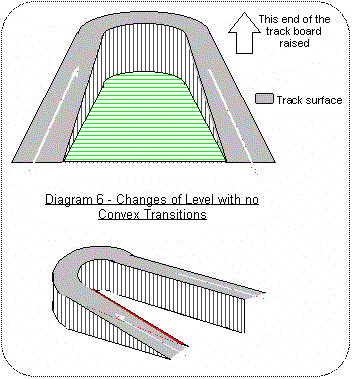
It is recommended that
such transitions are avoided. If a straight and the following bend are built on a
flat piece of board tipped up at an angle so that the outside of the bend is
raised you can produce a change in level without any concave transitions (see
diagram 6). The bend is slightly banked in this arrangement, and I would advise
keeping the gradient no steeper than 1 in 10. In order to avoid a negative
camber corners with this sort of feature the corner needs to be no more than
180 degrees. Unless you are sure you want steeply banked turns
don't have them.. they are difficult to build, there is usually trouble
with tapes / braid / track surface getting damaged (Unless cars
always have plenty of ground clearance, it only takes one low car
to damage the track!!) With banked tracks its quite tricky to avoid one lane
tending towards a launching ramp and in the unlikely event its not dangerous for
cars and spectators when you build it. more or less certain it will be after a
few years wear and warping. As a final thought on hills, if you really want a
hill with a concave transition at the top, then design it sufficiently sharp so
that everybody can see it and brake for it....this. will not solve the problems
of cars in the wrong lane flying off and hitting the clubroom wall etc. but at
least you avoid the unacceptable feature of cars launching on a straight some
laps and going down safely at full power on other laps.
Steeper bankings are generally no favoured on British club tracks, although they were widely used in the 1960s. However they are favored fro wing car racing. See separate section on banked tracks
Straights
The length of straights is an important feature of track layout. The shortest straight that can really be driven as a separate straight is about l.2m (4 ft.) ... perhaps a little longer if the bends at either end of it are of large radius ... perhaps somewhat less for home set cars. You can certainly build shorter straights than this but when a car is driven round them the corners at either end tend to merge into one continuous wiggle. It is normal to design tracks with a 'main straight' . . . a straight longer than the rest but there is no particular reason why you shouldnít have the two long straights of similar length if it fits your layout. How long this can be depends on the space available .. many club tracks are in the range 6 to 9m (20-30 ft.) and 10 or 11m (33 - 36 ft.) is long enough for most tastes. It tends to make track more interesting if there are a variety of different lengths of straight. Cars tend to fall out on long straights unless the surface is very good. The 1987-1993 Nationals track had a 12.45m (41 ft. 10 in. ) main straight (and we had plenty of trouble with cars launching on it). On very fast parts of the track this launching problem is certainly made worse by the slightest hint of a convex transition (see the Hills and Banking section above)... this can be due to a joint between two sheets of board, by sag in the board between supports, or just bumps in the tapes. If the middle of a very long straight is a few cm. lower than the ends and the corners at either end tipped up slightly (see above) then the cars will be going over a very slight concave transition along the length of the straight which will help keep them in the slot. Great care will be needed to ensure that there is a smooth concave profile all the way along.. a badly constructed attempt at this design will cause far more cars to deslot.
The marshals need easy access to the places cars are likely to fall off. They need to stationed where most cars come off - and those positions must not block the drivers view of the track. these days there is the option of a "TRACK" call if a car is in an unmarshallable position - I haven't come across many people who go to meetings to enjoy an interesting variety of track calls, so I think one can safely recommend that tracks should be designed to minimise the number of "TRACK" calls. Marshals can only reach over about 1.2 m (4 foot) of track, (obviously short drivers have rather less reach) so a 8 lane track is about the practical limit of track width. Leaning over 4 lanes to reach another 4 lane corner (see diagram 2) is practical, and a good space saving feature of many a club track. If a marshal has to reach too far they will probably have lean on the track surface, and they will take longer to marshal -either of which could have an impact on other cars! (I have no comment on alleged plans for 12 lane tracks marshalled by boy scouts)
Diagram 7 shows the sort of places cars are most likely to end up after falling off. Cars donít fall off until they start to go round a corner, perhaps the most common driving error is braking too late - and this leads to falling off just after the start of the corner. Another popular place to fall out is on the exit of the corner - (caused by putting on full power too early). Unless the corner tightens up, cars are less likely to fall off part way round, (once the driver has slowed the car enough to get it into the corner they tend not to boot it too hard till near the exit!) Once the car has come out it will carry on in a straight line until it either coasts to a stop or hits something. And where does the de-slotted car end up? If it falls off in a corner ... On club tracks it usually hit the barrier before coasting to a stop; on very fast corners, particularly on the inner lanes of 8 lane circuits the car will often coast to a stop before hitting the barrier. Cars that fall off on the exit to a corner it will continue along the following straight, and as likely as not it will end up in the path of another car. (It may end up in the wrong lane, in which case it is likely to exhibit the classic not braking enough for the next corner routine ... accompanied by some remarks from the driver!) The diagram shows a reasonable place for the marshal to stand - on a big bend a second marshal is a good idea.
Are there exceptions to this pattern of falling off? Well if the corner is so fast that you can apply full power before the exit, then obviously you wonít be able to deslot on the exit by putting on too much power. The 180 degree corner before going under the bridge on UK Black Nationals Track must be one of the fastest corners we race on, and deslotting on the exit to that is rare, but not unknown. There are few places where nobody can contrive to fall off - particularly with a bent car! A big 8 lane corner like that with a few degrees of banking is not enough to stop the occasional car deslotting on the exit ... so if you are designing anything tighter or less banked it would certainly be wise to assume cars will fall off on the exit. What does all this tell you? It tells you where the marshal will be doing his thing - so the marshal needs to be easy access to these places. It also shows where the marshal will be most of the time so you can work out how not to block the drivers view; it also tells you where not to put a bridge (unless you want accidents under it!) Cars donít generally come out of the slot on the straight, but once they have come out they will usually carry on down the straights for a long way before coming to rest.
The height of the track makes a difference to driver visibility and how far a marshal can reach. Traditionally British clubs have had the track at about table top or just below waist height height (say about 28 - 33 inches / 71 - 84cm above the floor) and the drivers are on a raised rostrum for improved visibility. Many North American tracks are at about knee height (say about 20 inches / 51cm above the floor) with the drivers standing on the floor. Obviously any track with gradients or bridges won't be the same height all the way round. Where maximum marshal reach is needed it is best not to have the track surface more than about 32 inches/81cm high, although it can be considerably higher where maximum marshal reach isn't needed.
Driver Visibility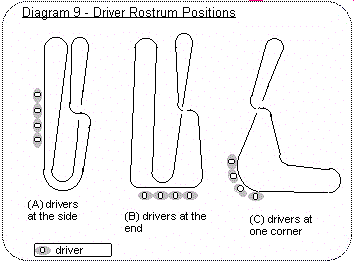
Drivers need to see their cars to brake and corner
them properly. In fact they donít really need to see them where they are on full
power. Bridges are one thing that can obstruct the drivers view (see above), but
what about Marshals? Some track designs place the marshals round the outside of
the track (e.g. North London) - so they do not obstruct a drivers view. The
track needs to be designed so that the marshals can reach all the necessary
parts of the track. If marshals are to be between the drivers and parts of the
track then driver visibility needs to be thought out carefully.
The position
of the rostrum is crucial to the drivers visibility of the track. Most tracks
have the drivers stood side by side in the same order as the lanes. Some tracks
have the drivers along side the longest straight (diagram 9 - (A) drivers at the
side) so the cars are predominantly passing from side to side, others have the
drivers at one end (diagram 9 - (B) drivers at the end) so the cars are
predominantly passing away from and towards the drivers. Most drivers are happy
enough to drive from either position (as long as visibility is adequate)
although I know some people have a strong preference for either (A) or (B). I
would strongly recommend you work out where the drivers can best see the track,
and best fit in the clubroom,... donít worry about if its more like (A) or (B)
indeed why not see if putting the drivers in a corner would work (diagram 9 (C))
- Its some years since Iíve seen a track built like (C), - it can make good use
of an awkward shape club room and provide the drivers with a good view of the
track. (For (C) to work properly the marshal for the corner where the drivers
are standing needs to be seated inside the corner. The need for a seated marshal
is illustrated in diagram 14.) If drivers can put their car on in a corner
(rather than on a straight), they need to be extra careful to look for other
cars so as to avoid collisions (When a driver puts his car on the track there is
likely to be some delay before he drives it away - not a problem if the car is
on a straight - but on a corner? .. I hope everybody knows about not parking in
the middle of corners! ) 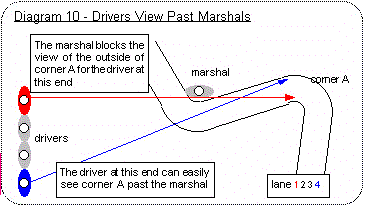
The drivers need at
least 0.6m (2 ft.) width to stand, so that adds up to 2.4m (8ft.) for a 4 lane
track and 4.8m (16 ft.) for 8 lanes. This means that it is pretty well essential
to have the drivers at the side of a 8 lane track. Diagram 10 illustrates how
putting the drivers at the right end of the rostrum can make an important
difference to corner visibility. The driver at the top of the diagram were
driving lane number 4 (blue if you have printed this out in colour) the marshal
would be blocking his view of corner A , but if this driver is controlling lane
number 1 (red) and the driver at the bottom on the diagram has lane number 4
(blue) then nobody has a visibility problem. (Have I confused you yet? - have
another look at the diagram!)
Drivers need to see their cars to brake and corner
them properly. In fact they donít really need to see them where they are on full
power. Bridges are one thing that can obstruct the drivers view (see above), but
what about Marshals? Some track designs place the marshals round the outside of
the track (e.g. North London) - so they do not obstruct a drivers view. The
track needs to be designed so that the marshals can reach all the necessary
parts of the track. If marshals are to be between the drivers and parts of the
track then driver visibility needs to be thought out carefully.
A pair of 180 degree bends side by side is seen on many club tracks as it makes very good use of the space in many club rooms. Diagram 11 shows how reversing the direction of travel makes a big difference to the areas where marshals need access. The upper half of the diagram shows there is no visibility problem, (and space can be saved by reducing or even removing the gap in the middle). the lower half of the diagram shows that by reversing the direction of travel the marshals will be blocking the drivers view, and space is needed between the straights for marshal access. Good examples of how this works are North London and Bournemouth SRS. There are plenty of other configurations where the direction of travel is important, this is something that need thought when designing a track.
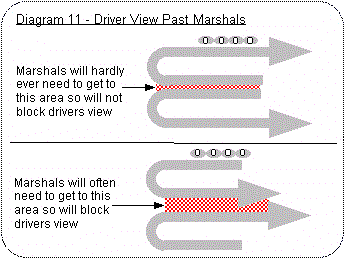
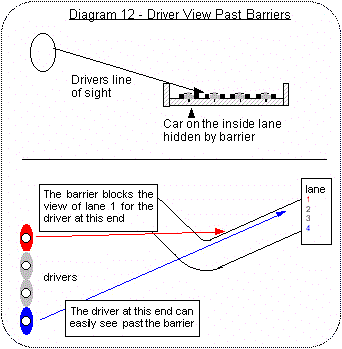
Diagram 12 shows how the barriers can block the drivers view of some parts of the track. The problems are usually worst on corners furthest away from the drivers, there is a better angle to see over the top of nearby barriers. Formula 1 cars are usually the lowest and therefore most likely type of car to be hidden . The options to provide the driver with a better view are:-
a) Lower the barrier - Barriers do need to be 5 cm. (2 in.) or more high to do their job in places where there is any significant chance cars will hit them. 5 cm. is about twice the height of the top of a typical F1 car air box .
b) Move the barrier further away from the slot - this can work well if it fits in with the rest of the track and does not produce an unmarshallable position.
c) Have the track lower - North American 8 lane tracks tend to be at about knee height rather than the normal British club track just below waist height. This gives the driver a better angle to see over the barriers - particularly if he drivers are standing on the floor.
d) Have the driver standing higher - Giving the driver a better angle to see over the barriers depends on the height of the drivers head above the track - so raising the drivers or lowering the track can have similar benefits although there are some limitations with the drivers stood on the floor. In extreme cases (For example some venues for the 6 lane Nationals tracks used prior to 1993) the drivers were stood on a stage at least a meter (over 3 ft.) higher than the track surface, and in need of a pit man to change over their cars during practice. However, normal club tracks have the driver standing no higher than the track surface and close enough so the can reach over and put their own cars on. Raising the drivers rostrum 0.5 m (20 in)or a bit more helps a lot with visibility, but obviously space is needed for sensible (safe!) steps and sufficient ceiling height is needed for taller drivers.
e) Transparent barrier has solved many a visibility problem. The only thing wrong with them is that the transparent plastic is not usually as tolerant of cars smashing into it as a MDF or hardboard barrier. This is not usually a problem because its usually the inside barrier that blocks the view and the outside barrier where the banging and crashing occurs.
f) The lower part of diagram 12 illustrates how putting the drivers at the right end of the rostrum can make a difference to visibility over the barriers. The driver at the top of the diagram cannot see lane number 4 (blue) properly because the barrier is blocking his view , but if this driver at the bottom of the diagram has an unobstructed view of lane number 4 (blue), so if you arrange the drivers in the appropriate way nobody has a visibility problem. In this example the drivers will be better placed to see past the marshal as well as the barrier (see diagram 10).
Although most tracks have the outside lanes at either end of the rostrum, thereís is the occasional design where a potential visibility problem can be solved by putting the outside lanes towards the middle of the rostrum. A good example of this was the Super 8 track (used for the 1997 ISRA World Championships) where Steve Ogilvie avoided a visibility problem on some of the corners by moving the driving positions for 3 lanes to the opposite end of the rostrum. The drivers of the two outside lanes were next to each other, but apart from that the driver stood next to you was driving the next lane. Curiously several drivers thought the driving positions were jumbled at random even though there was just the single change from the "normal" order.
A feature of having all the
drivers standing along a straight is that they can block one anotherís view of
the track. This can be helped by moving the rostrum back a little way from the
track -everybody standing back by a foot (0.3m) can improve this substantially -
so try and allow some space for people to be able to stand back. It is tempting
to use every last bit of floor area, but this extra space can be quite a big
help in visibility. It helps if the middle lane drivers can get on the rostrum
after the outside lane drivers have arrived! (and some slot racers are not that
thin - remember Jim Huxley?) If clubroom space is really tight then space
rostrum space has to be compromised, but in most club rooms the extra few inches
of track length does not compensate for the need to shuffle the more generously
proportioned racers round the room in the right order.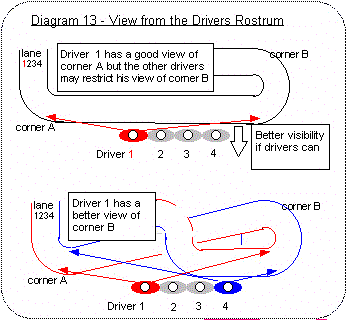
Diagram 13 shows another way of improving the drivers view. In
the top layout Driver 1ís view of corner B is impaired by the other drivers, but
driver 4 has little problem because he is driving lane number 4 (blue) - the
inside of both corners. Swapping the drivers round wouldnít help - the driver
with the outside lane has the same problem which ever end of the rostrum he is
standing. This illustrates a more general point - if you solve a visibility
problem at one corner by swapping the drivers round you need to check this
hasnít caused a visibility problem somewhere else. However, there is a way round
this particular problem... The lower part of diagram 13 shows a layout that puts
the inside lane of corner A on the outside of corner B. Driver 1 now has the
inside lane of corner B, so can see it better. Driver 4 still has the inside
lane of corner A, but now has the outside of corner B which presents no
visibility problems because he is stood at the right end of the rostrum with no
drivers to his right to obstruct his view. (all right that sounds a bit
complicated - have another look at the diagram!) An example of this is the
Bournemouth SRS track ( The complete layout of this track is shown in the
Oct/Nov 1998 SCRN).
If the marshal is seated then drivers can see over the top of them, but the view of the space immediately behind the marshal will be obstructed. If you are relying on the drivers seeing over the top of the marshal, its advisable to draw it out to scale to make sure where the "blind spots" are (see diagram 14 - I havenít put sizes in this diagram because the will depend on how high the track is from the ground, the height of the marshals chair, the height of the drivers rostrum etc.)
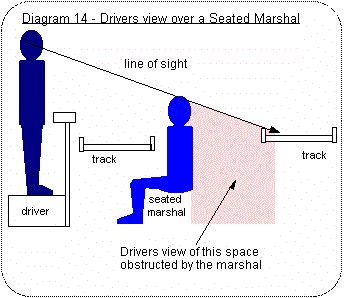
A common problem with
any sort of design is that if you solve one problem you create a problem
somewhere else. So just when you thought Iíd come up with enough things to think
about, what should the track design do to make the race controllers job less
difficult.
The race controller does need enough table space for the lap counters, space to work out the results and somewhere to sit down. Most track layouts allow some space for race control, either round the outside of the room, or perhaps in some spare space in the middle of the track layout. Ideally the race controller needs:
(a) to see the start line (So he can see if all the cars are on the line for the start, and order a restart if a car fails to leave the line. To help resolve claims for missing / extra laps. To ensure nobody even thinks about adding extra laps!)
(b) to see the drivers (So he can see who is missing when everybody else is ready and waiting to start. So he can observe driver conduct and tell the appropriate people to calm down.)
(c) to see the marshalling positions (So he knows if the positions are all covered for the start of a race and can invite competitors to fill the empty spaces promptly. )
(d) to see the first corner (So he can order a restart if half the field fall off.)
If the track has some sort of automatic timer, or even a computerised race control system, it can be useful for the race controller to get to a marshalling position once the race has started - and preferably get there before the cars arrive on their first lap. Obviously a full time race controller is preferable (and essential to "TRACK" calls), but on a badly attended club night an extra marshal can be very valuable.
Its useful to raise the race control position 0.2 - 0.6 m (a foot or two) off the ground - a seated race controller can see past standing people much easier if heís sitting a bit higher. It can be useful to have race control near the door so he can keep an eye on who is coming and going (and jog the memory of anybody who is leaving without paying their race fees). There is also something to be said for having the race control position out of the way from disturbance by the drivers. Its much easier to add up the results without continual interruptions! I remember the Loughborough club where the race controllers chair was also used as the step up to the drivers rostrum, the race controller was often inconvenienced by drivers stepping up on this chair (particularly if he was sitting on it at the time!) .. this does have a happy ending - eventually race control was moved to unused space in the middle of the layout.
Obviously the ideal race control position is less important than getting many other aspects of the design right. A marshal can tell the race controller if cars have missed laps etc. ... as long as the marshal is responsible and unbiased. A little thought at the track design stage can save a lot of trouble later.
Door and Windows
Its a good idea to allow a reasonable amount of space round the clubroom door. I have seen clubs (which I will not name) where late arrivals at the club room opened the door and rammed a marshal in the back! Also vacating the premises at the end of a club night was worse than getting out of tube train in the rush hour. So try and allow at least twice as much room round the door as you allow round the rest of the track.
Lighting needs a little thought. Most club racing takes place after dark, so are the lights in a reasonable place? Its always easier to install extra lights before the track is built. Also will it be possible to change light bulbs / tubes without damaging the track? This shouldnít be a problem with most track designs, buts itís worth thinking through just in case.
If the clubroom has opening windows, can you get at them to open and close them each club night? Again this is unlikely to change the track design, but just in case.... (On the subject of windows - Does the sun shine across the track straight into the drivers eyes? If so some blinds, curtains or even posters taped to the windows can solve the problem. Can the public see the track through the windows? Is this a good idea? We want to publicise slot racing but we donít want to attract vandals! In many locations, I think its better if people cannot see in. Opaque film on the glass will solve this problem.)
Is the design
suitable?
OK so now youíve drawn a few possible track designs, Now
draw in the drivers, race controller, marshals and any spectator areas then
check all the following point:-?
(a) Will it fit the club room?
(b) Can the drivers see all the corners and most of the length of each straight. (Remember marshals, the race controller, spectators, pillars, barriers and the track itself could block the drivers view)?
(c) Can the marshals easily reach all the places cars are likely to fall off?
(d) Are the bridges arranged to minimise the chances of de-slotted cars ending up parked under them?
(e) Is there space to get in the club room door and walk round the track?
(f) Are all parts of the track accessible? (Cars can land anywhere - visits to the scenery will hopefully be rare but all parts of the track may need maintenance.)
(g) Marshals should have easy access to marshalling positions. (If marshalling positions are difficult to get to or uncomfortable the inevitable lack of marshals delays racing)
(h) Make sure the number of marshals required isn't too great compared with the likely turn out on a club night. (Its useful to be able to run with reduced marshals, so if possible one person should be able to cover 2 positions. slow marshalling is better than "sorry folks no racing tonight - there arenít enough marshals".)
(i) Is there a reasonable position for race control?
(j) If you, are building a portable track think about where the joints are, the size of the pieces and how much space is needed for storage.
Good thing you worked it out
when the track was still a paper design so its easy to move the corners and/or
drivers to provide a better solution. Once youíve worked through that list,
sworn a few times about the number of changes to the designs etc. you should
have arrive at a much better design than your first attempt. Donít worry about
not having the perfect answer to everything - like so much else in life if you
are looking for perfection youíll go on for a long long time, and the design
will still not please everybody. Its a good idea to come up with a few
alternative layouts and ask other club members for their views. Hopefully this
will still be the sort of track the club originally agreed they wanted - but if
for example the club wanted a 6 lane track but the club room is only big enough
for 4 then its not too late for a rethink! Try and discuss it in an orderly way
- If for example not everybody agrees on how few marshals you are likely to have
on a bad night, its better to discuss that and come to a decision without
confusing the discussion with other features of the track design. After a bit
more thought, you should end up with a design most people like - and a good job
they do because they are all volunteering to help build it! Now you can plan the
construction... and when you are ready to start thinking about that go to the
series of articles describing how to build your track design.
Chris
Frost
Copyright © 1998 British Slot Car Racing Association All rights reserved
updated April 2012, June, September 2009 August 2020 and November 2022
No liability is accepted for this information or any use to which it may be put